maven安装与配置
Maven的安装与配置
一、安装本地Maven
-
点此进入maven官网下载
-
选择左侧Download

-
点击箭头所指的链接进行下载,本文采用3.5.4进行安装
-

-
下载完成后,选择一个路径进行解压(本文选用 D:\JAVA\apache-maven-3.5.4 路径)
-
然后配置path环境变量,如图
- 系统变量:MAVEN_HOME =D:\JAVA\apache-maven-3.5.4
- 系统变量:path = %MAVEN_HOME%\bin
MAVEN_HOME:
path:

- 然后win+R 运行cmd 输入 mvn -version,如图所示则配置成功
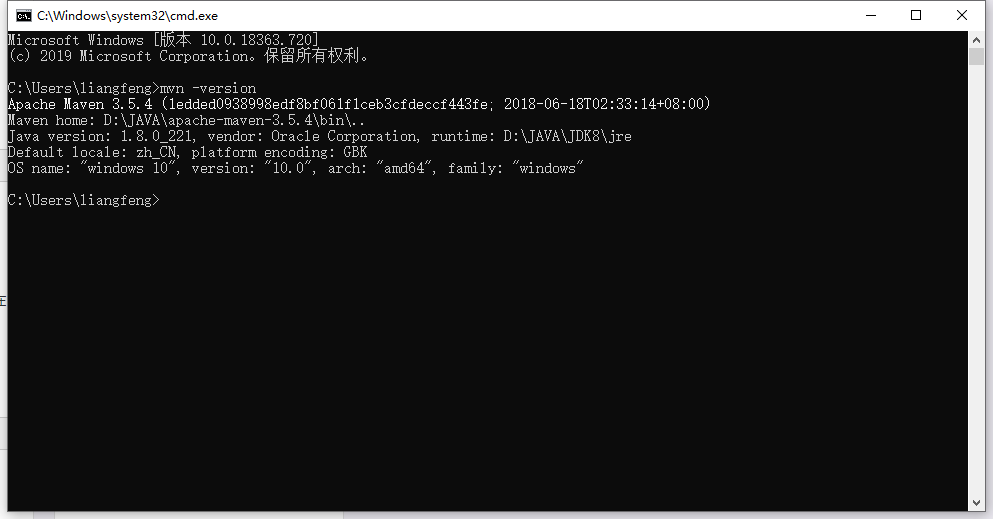
(本文采用3.5.4版本安装)
二、配置settings文件
-
在D:\JAVA\apache-maven-3.5.4\conf下可以找到settings文件,打开(嫌麻烦的直接看最后一步)
-
找到第52行,这里是maven默认的仓库

-
我们复制第53行
<localRepository>/path/to/local/repo</localRepository>
将它拿到注释外并将中间的内容改成你需要的路径,如图
<localRepository>D:/JAVA/maven-repository</localRepository>
这里的路径随便设置,注意这里是正斜杠
- 因为国外的服务器下载jar包很慢所以我们改为阿里云服务器(大约在150行左右),这两个仓库只用选一个
1 <!-- 阿里云仓库 --> 2 <mirror> 3 <id>alimaven</id> 4 <mirrorOf>central</mirrorOf> 5 <name>aliyun maven</name> 6 <url>http://maven.aliyun.com/nexus/content/repositories/central/</url> 7 </mirror> 8 或者 9 <mirror> 10 <id>nexus-aliyun</id> 11 <mirrorOf>*</mirrorOf> 12 <name>Nexus aliyun</name> 13 <url>http://maven.aliyun.com/nexus/content/groups/public</url> 14 </mirror>
-
如图,要夹在两个mirrors标签之间

-
在最后配置jdk,也要夹在两个profiles标签之间
1 <!—java版本 --> 2 <profile> 3 <id>jdk-1.8</id> 4 <activation> 5 <activeByDefault>true</activeByDefault> 6 <jdk>1.8</jdk> 7 </activation> 8 9 <properties> 10 <maven.compiler.source>1.8</maven.compiler.source> 11 <maven.compiler.target>1.8</maven.compiler.target> 12 <maven.compiler.compilerVersion>1.8</maven.compiler.compilerVersion> 13 </properties> 14 </profile>

-
配置完成,在命令行输入mvn help:system测试,看到下载链接里面是ailiyun的链接表示配置成功
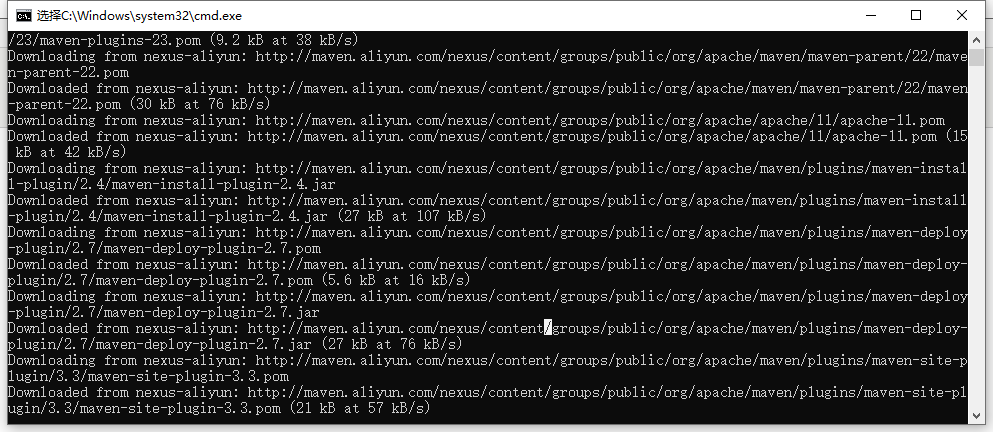
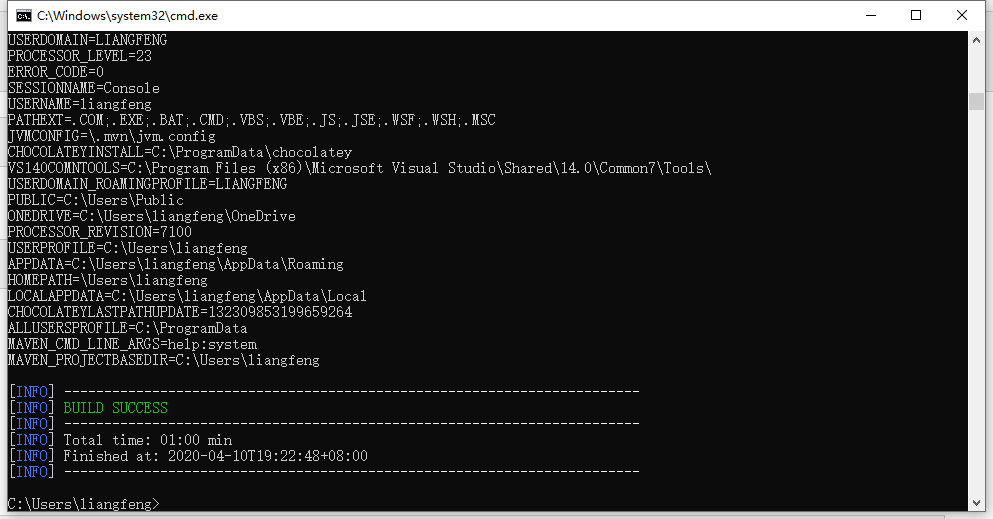
-
嫌麻烦的直接复制配置文件的内容即可,不过路径还是要改(参考第3步)
1 <?xml version="1.0" encoding="UTF-8"?> 2 3 <!-- 4 Licensed to the Apache Software Foundation (ASF) under one 5 or more contributor license agreements. See the NOTICE file 6 distributed with this work for additional information 7 regarding copyright ownership. The ASF licenses this file 8 to you under the Apache License, Version 2.0 (the 9 "License"); you may not use this file except in compliance 10 with the License. You may obtain a copy of the License at 11 12 http://www.apache.org/licenses/LICENSE-2.0 13 14 Unless required by applicable law or agreed to in writing, 15 software distributed under the License is distributed on an 16 "AS IS" BASIS, WITHOUT WARRANTIES OR CONDITIONS OF ANY 17 KIND, either express or implied. See the License for the 18 specific language governing permissions and limitations 19 under the License. 20 --> 21 22 <!-- 23 | This is the configuration file for Maven. It can be specified at two levels: 24 | 25 | 1. User Level. This settings.xml file provides configuration for a single user, 26 | and is normally provided in ${user.home}/.m2/settings.xml. 27 | 28 | NOTE: This location can be overridden with the CLI option: 29 | 30 | -s /path/to/user/settings.xml 31 | 32 | 2. Global Level. This settings.xml file provides configuration for all Maven 33 | users on a machine (assuming they're all using the same Maven 34 | installation). It's normally provided in 35 | ${maven.conf}/settings.xml. 36 | 37 | NOTE: This location can be overridden with the CLI option: 38 | 39 | -gs /path/to/global/settings.xml 40 | 41 | The sections in this sample file are intended to give you a running start at 42 | getting the most out of your Maven installation. Where appropriate, the default 43 | values (values used when the setting is not specified) are provided. 44 | 45 |--> 46 <settings xmlns="http://maven.apache.org/SETTINGS/1.0.0" 47 xmlns:xsi="http://www.w3.org/2001/XMLSchema-instance" 48 xsi:schemaLocation="http://maven.apache.org/SETTINGS/1.0.0 http://maven.apache.org/xsd/settings-1.0.0.xsd"> 49 <!-- localRepository 50 | The path to the local repository maven will use to store artifacts. 51 | 52 | Default: ${user.home}/.m2/repository 53 <localRepository>/path/to/local/repo</localRepository> 54 --> 55 <localRepository>F:/repository</localRepository>· 56 <!-- interactiveMode 57 | This will determine whether maven prompts you when it needs input. If set to false, 58 | maven will use a sensible default value, perhaps based on some other setting, for 59 | the parameter in question. 60 | 61 | Default: true 62 <interactiveMode>true</interactiveMode> 63 --> 64 65 <!-- offline 66 | Determines whether maven should attempt to connect to the network when executing a build. 67 | This will have an effect on artifact downloads, artifact deployment, and others. 68 | 69 | Default: false 70 <offline>false</offline> 71 --> 72 73 <!-- pluginGroups 74 | This is a list of additional group identifiers that will be searched when resolving plugins by their prefix, i.e. 75 | when invoking a command line like "mvn prefix:goal". Maven will automatically add the group identifiers 76 | "org.apache.maven.plugins" and "org.codehaus.mojo" if these are not already contained in the list. 77 |--> 78 <pluginGroups> 79 <!-- pluginGroup 80 | Specifies a further group identifier to use for plugin lookup. 81 <pluginGroup>com.your.plugins</pluginGroup> 82 --> 83 </pluginGroups> 84 85 <!-- proxies 86 | This is a list of proxies which can be used on this machine to connect to the network. 87 | Unless otherwise specified (by system property or command-line switch), the first proxy 88 | specification in this list marked as active will be used. 89 |--> 90 <proxies> 91 <!-- proxy 92 | Specification for one proxy, to be used in connecting to the network. 93 | 94 <proxy> 95 <id>optional</id> 96 <active>true</active> 97 <protocol>http</protocol> 98 <username>proxyuser</username> 99 <password>proxypass</password> 100 <host>proxy.host.net</host> 101 <port>80</port> 102 <nonProxyHosts>local.net|some.host.com</nonProxyHosts> 103 </proxy> 104 --> 105 </proxies> 106 107 <!-- servers 108 | This is a list of authentication profiles, keyed by the server-id used within the system. 109 | Authentication profiles can be used whenever maven must make a connection to a remote server. 110 |--> 111 <servers> 112 <!-- server 113 | Specifies the authentication information to use when connecting to a particular server, identified by 114 | a unique name within the system (referred to by the 'id' attribute below). 115 | 116 | NOTE: You should either specify username/password OR privateKey/passphrase, since these pairings are 117 | used together. 118 | 119 <server> 120 <id>deploymentRepo</id> 121 <username>repouser</username> 122 <password>repopwd</password> 123 </server> 124 --> 125 126 <!-- Another sample, using keys to authenticate. 127 <server> 128 <id>siteServer</id> 129 <privateKey>/path/to/private/key</privateKey> 130 <passphrase>optional; leave empty if not used.</passphrase> 131 </server> 132 --> 133 </servers> 134 135 <!-- mirrors 136 | This is a list of mirrors to be used in downloading artifacts from remote repositories. 137 | 138 | It works like this: a POM may declare a repository to use in resolving certain artifacts. 139 | However, this repository may have problems with heavy traffic at times, so people have mirrored 140 | it to several places. 141 | 142 | That repository definition will have a unique id, so we can create a mirror reference for that 143 | repository, to be used as an alternate download site. The mirror site will be the preferred 144 | server for that repository. 145 |--> 146 147 <!-- mirror 148 <mirrors> 149 | Specifies a repository mirror site to use instead of a given repository. The repository that 150 | this mirror serves has an ID that matches the mirrorOf element of this mirror. IDs are used 151 | for inheritance and direct lookup purposes, and must be unique across the set of mirrors. 152 | 153 <mirror> 154 <id>mirrorId</id> 155 <mirrorOf>repositoryId</mirrorOf> 156 <name>Human Readable Name for this Mirror.</name> 157 <url>http://my.repository.com/repo/path</url> 158 </mirror> 159 </mirrors> 160 --> 161 <!-- 阿里云仓库 --> 162 <mirrors> 163 <mirror> 164 <id>nexus-aliyun</id> 165 <mirrorOf>*</mirrorOf> 166 <name>Nexus aliyun</name> 167 <url>http://maven.aliyun.com/nexus/content/groups/public</url> 168 </mirror> 169 170 <!-- 中央仓库1 --> 171 <mirror> 172 <id>repo1</id> 173 <mirrorOf>central</mirrorOf> 174 <name>Human Readable Name for this Mirror.</name> 175 <url>http://repo1.maven.org/maven2/</url> 176 </mirror> 177 178 <!-- 中央仓库2 --> 179 <mirror> 180 <id>repo2</id> 181 <mirrorOf>central</mirrorOf> 182 <name>Human Readable Name for this Mirror.</name> 183 <url>http://repo2.maven.org/maven2/</url> 184 </mirror> 185 186 </mirrors> 187 <!-- profiles 188 | This is a list of profiles which can be activated in a variety of ways, and which can modify 189 | the build process. Profiles provided in the settings.xml are intended to provide local machine- 190 | specific paths and repository locations which allow the build to work in the local environment. 191 | 192 | For example, if you have an integration testing plugin - like cactus - that needs to know where 193 | your Tomcat instance is installed, you can provide a variable here such that the variable is 194 | dereferenced during the build process to configure the cactus plugin. 195 | 196 | As noted above, profiles can be activated in a variety of ways. One way - the activeProfiles 197 | section of this document (settings.xml) - will be discussed later. Another way essentially 198 | relies on the detection of a system property, either matching a particular value for the property, 199 | or merely testing its existence. Profiles can also be activated by JDK version prefix, where a 200 | value of '1.4' might activate a profile when the build is executed on a JDK version of '1.4.2_07'. 201 | Finally, the list of active profiles can be specified directly from the command line. 202 | 203 | NOTE: For profiles defined in the settings.xml, you are restricted to specifying only artifact 204 | repositories, plugin repositories, and free-form properties to be used as configuration 205 | variables for plugins in the POM. 206 | 207 |--> 208 <!-- profile 209 <profiles> 210 | Specifies a set of introductions to the build process, to be activated using one or more of the 211 | mechanisms described above. For inheritance purposes, and to activate profiles via <activatedProfiles/> 212 | or the command line, profiles have to have an ID that is unique. 213 | 214 | An encouraged best practice for profile identification is to use a consistent naming convention 215 | for profiles, such as 'env-dev', 'env-test', 'env-production', 'user-jdcasey', 'user-brett', etc. 216 | This will make it more intuitive to understand what the set of introduced profiles is attempting 217 | to accomplish, particularly when you only have a list of profile id's for debug. 218 | 219 | This profile example uses the JDK version to trigger activation, and provides a JDK-specific repo. 220 <profile> 221 <id>jdk-1.4</id> 222 223 <activation> 224 <jdk>1.4</jdk> 225 </activation> 226 227 <repositories> 228 <repository> 229 <id>jdk14</id> 230 <name>Repository for JDK 1.4 builds</name> 231 <url>http://www.myhost.com/maven/jdk14</url> 232 <layout>default</layout> 233 <snapshotPolicy>always</snapshotPolicy> 234 </repository> 235 </repositories> 236 </profile> 237 --> 238 239 <!-- 240 | Here is another profile, activated by the system property 'target-env' with a value of 'dev', 241 | which provides a specific path to the Tomcat instance. To use this, your plugin configuration 242 | might hypothetically look like: 243 | 244 | ... 245 | <plugin> 246 | <groupId>org.myco.myplugins</groupId> 247 | <artifactId>myplugin</artifactId> 248 | 249 | <configuration> 250 | <tomcatLocation>${tomcatPath}</tomcatLocation> 251 | </configuration> 252 | </plugin> 253 | ... 254 | 255 | NOTE: If you just wanted to inject this configuration whenever someone set 'target-env' to 256 | anything, you could just leave off the <value/> inside the activation-property. 257 | 258 <profile> 259 <id>env-dev</id> 260 261 <activation> 262 <property> 263 <name>target-env</name> 264 <value>dev</value> 265 </property> 266 </activation> 267 268 <properties> 269 <tomcatPath>/path/to/tomcat/instance</tomcatPath> 270 </properties> 271 </profile> 272 273 --> 274 <profiles> 275 <profile> 276 <id>jdk-1.8</id> 277 <activation> 278 <activeByDefault>true</activeByDefault> 279 <jdk>1.8</jdk> 280 </activation> 281 282 <properties> 283 <maven.compiler.source>1.8</maven.compiler.source> 284 <maven.compiler.target>1.8</maven.compiler.target> 285 <maven.compiler.compilerVersion>1.8</maven.compiler.compilerVersion> 286 </properties> 287 </profile> 288 </profiles> 289 290 291 292 <!-- activeProfiles 293 | List of profiles that are active for all builds. 294 | 295 <activeProfiles> 296 <activeProfile>alwaysActiveProfile</activeProfile> 297 <activeProfile>anotherAlwaysActiveProfile</activeProfile> 298 </activeProfiles> 299 --> 300 </settings>
到此,settings.xml全部修改完成
下面进行IDEA中maven本地库的配置:
1、选择设置
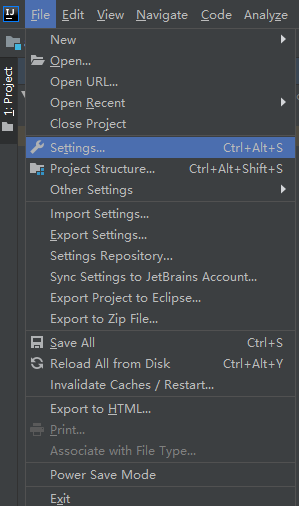
2、搜索maven,配置maven版本,本地仓以及settings.xml的路径。
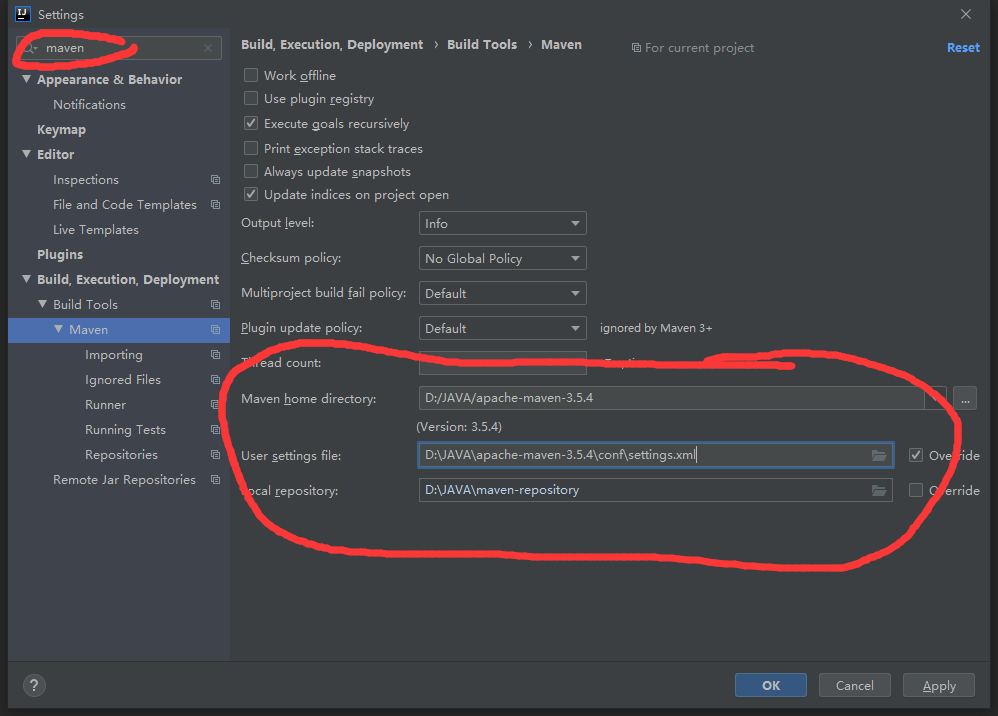
选择应用,配置完成。



